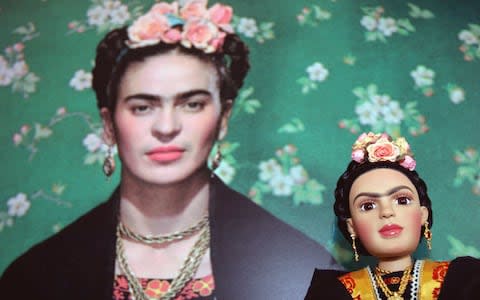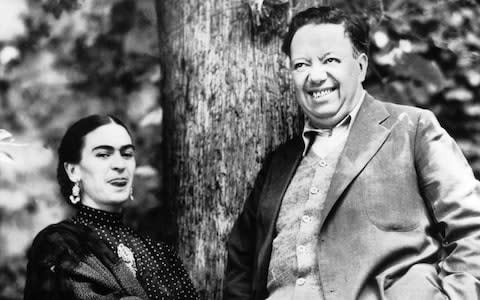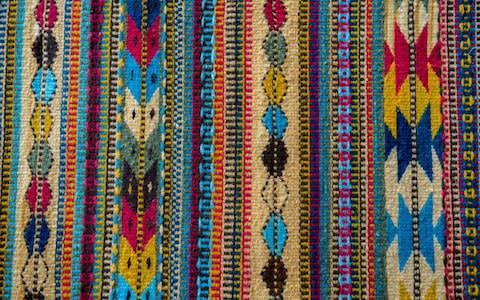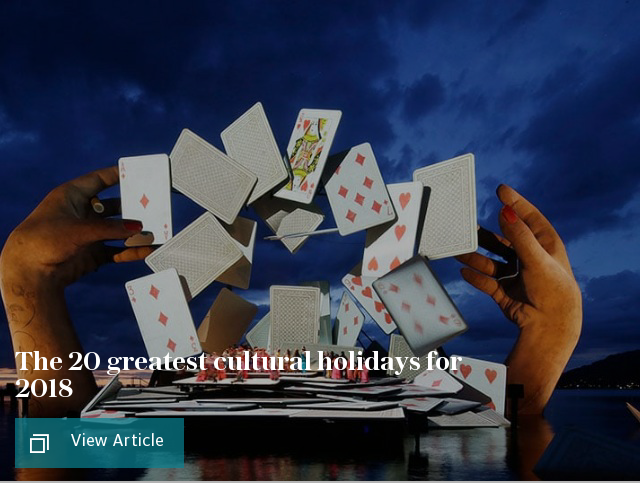On the trail of Frida Kahlo, the Mexican communist with the famous monobrow

Rolling her thumb and forefingers together, Pastora Gutiérrez Reyes appears to be drawing ruby globules of blood. “Cochineal,” she says, pointing to a bowl of tiny ashen-grey beetles plucked from cactus pads and crushed to make a red dye. Along with pecan shells, pomegranate seeds and Brazil wood, carminic acid is one of several natural pigments used to colour wools woven by Vida Nueva, a women’s co-operative set up by Pastora and her sister Silvia 22 years ago in dusty Oaxacan village Teotitlan.
Coils of yarn as fine as angel hair hang from walls in a courtyard, where the 45-year-old sits at a wooden loom, two thick black plaits framing her face and trailing onto a bed of roses embroidered into her blouse. In the past, only men were permitted to weave, but when many moved to the US for work, economic necessity gave Teotitlan’s Zapotec women a chance to earn both money and respect.

A traditional motif of two triangles decorating the rug Pastora is making represents a butterfly, she tells me – a symbol of freedom. The diamond it sits within denotes power and strength. Indigenous textile designs are loaded with meaning, so when Mexican artist Frida Kahlo adopted Oaxacan clothing as her daily dress, she was making more than a fashion statement.
Now the greatest international exponent of Mexico’s colourful cloths is the focus of V&A London’s latest blockbuster exhibition, Frida Kahlo: Making Her Self Up, which opens this weekend. Printed cotton huipiles (tunics) and floor-length, lace-trimmed enaguas (skirts) are among items unearthed from a sealed baúl (trunk) in 2004, 50 years after Kahlo’s death, on display outside her home country for the first time.
From the skulls and spider monkeys painted in self-portraits, to a wardrobe of flamboyant outfits, jangling jewellery and marigolds in her hair, every symbol, motif and piece of clothing Kahlo chose was carefully choreographed. They represented a Mexico she knew and loved.

At the Sunday market in Tlacolula, women from across the Oaxacan state are distinguishable by their regional dress. Gold thread flickers from the rebozo (headscarves) worn by ladies from San Bartolome Quialana and woollen turbans curl into neat trivet knots crowning the mothers and daughters of Yalalag.
Grilling goat meat on an open charcoal fire, mestizos are draped in a treasure trove of pirates’ jewels; flames dance around their ears and sparks flash from knuckles as they stuff the soft, fatty flesh into tacos. Sitting at long tables in the dark, smoky hall are women in velvet tunics bursting with big, bold blooms – a style from the matriarchal Isthmus of Tehuantepec, which Kahlo famously embraced.
Although an early photograph shows Kahlo’s maternal family wearing similar dress, the artist, dubbed a circus freak for her unusual choice of wardrobe, wasn’t simply continuing a family tradition. A bastion of indigenous culture, animated folklore and nostalgic home-cooked cuisine, Oaxaca is also one of the poorest states in Mexico – so it is no accident communist-leaning Kahlo wanted to align herself with these mountains and valleys.

There are multiple churches in state capital Oaxaca City, a colonial masterpiece, and religion morphs with magical realism in vaulted ceilings embellished with vines and a painting of Jesus pondering chilli peppers at the Last Supper. In a small museum behind the Basilica de la Soledad, images of the Virgin of Solitude decorate small metal ex-votos covering the walls. The city’s patron saint floats on clouds or appears in a puff of smoke in scenes commissioned by worshippers as thanks for miracles.
Kahlo was fascinated by the ritual and created her own secular versions, including the disturbing Henry Ford Hospital, where she lies on a bloodied bed below the spectre of a foetus – an allusion to her inability to conceive. Pain and suffering dominated Kahlo’s work, and sympathy for her tragic life partly explains her popularity. As a child she contracted polio and at the age of 18 a horrific tram accident left her disabled and needing 30 operations throughout her life. Then there was her tumultuous marriage to artist Diego Rivera and the multiple affairs that ensued.
After her death in 1954, Kahlo became an icon. Her defiant monobrow arches from hessian shopping bags sold in market stalls, and pop art portraits glare from notebooks, T-shirts and slippers in souvenir stores. An hour’s drive south of Oaxaca, Josefina Aguilar moulds clay muñecas (dolls) of Kahlo and sells them to tourists for 200 pesos (£7). When I arrive at her workshop on the outskirts of Ocotlan de Morelos, the frail 73-year-old is dozing in a chair. She is surrounded by shelves stacked with petal-fringed figures carrying monkeys, and an interpretation of The Two Fridas wearing beating atria around their necks.

“I can’t read or write, so I listen to the stories people tell me,” she whispers in Spanish. Although they never met, as a woman from Oaxaca she felt close to Kahlo, leading her to create one of her favourite pieces – a two-headed doll featuring the artist’s face and her own.
Similarly, Beatriz Vásquez Gómez, who runs a food stall in the covered village market, identifies with Kahlo – so much so, she dresses up like her every day. “Like Frida, I have had many disappointments,” laments the unmarried 53-year-old, pursing her lips to even out a streak of scarlet lipstick. “She is an example; she gives me the strength to continue.”
When Beatriz was in her late 20s, her father gave her a biography about Kahlo and she noticed her own uncanny resemblance to the unconventionally beautiful woman. Eight years ago, her heroine appeared in a dream, wrapping Beatriz in “a white sheet and a dragonfly, and telling me to fly and not be afraid”. She rebranded her mother’s stall as La Cocina de Frida and has enjoyed a steady stream of selfie-seeking tourists ever since. Now she is learning to make some of Kahlo’s favourite recipes. “I even bathe like her,” she exclaims, verging on fanatical. “And I perfume my underwear with rose petals.”

Despite her emotional connection to the south, Kahlo lived in Mexico City. Her home, the celestial-blue Casa Azul, is now a museum, and queues snake for up to four hours along the leafy streets. Inside, a vanity mirror above the bed and a wheelchair are reminders of Kahlo’s physical limitations. In the city’s historic centre, Rivera’s social and political murals are splashed across the interior of art deco marvel the Palacio de Bellas Artes. Scenes of conquistadors and dictators subjugating indigenous people express the radical post-revolution beliefs he shared with Kahlo.
“There have been two great accidents in my life. One was the trolley, and the other was Diego. Diego was by far the worst,” wrote Kahlo of the husband she adored and reviled in equal measure.
Seeking to understand the complexities of their relationship, I travel to San Miguel de Allende, a colonial city in the central highlands, where American Graeme Howard claims to own a collection of intimate letters, drawings and “suicide notes” discovered in a traditional Michoacan box engraved with Kahlo’s initials.

Carefully preserved in glass cabinets on the upper floor of Howard’s art-filled house, The Heart of Frida collection was authenticated by Los Fridos student Arturo García Bustos but later denounced by critics as fake. Graeme still claims the items are genuine and mystery coils around the controversy like smoke from one of Kahlo’s sketched marijuana cigarettes.
Real or not, the scribbles on notepaper and losing lottery tickets are convincing; Rivera “the useless amphibian” repeatedly appears as a toad and Kahlo is depicted as a butterfly. Mexico’s fauna and flora regularly decorated her self-portraits.
A symbol of national pride, monarch butterflies migrate thousands of miles every year from North America and Canada, spending summer in the pine forests of Michoacan and Mexico states. Accessing the upper reaches of Sierra del Rosario Biosphere Reserve on horseback, I ride through a storm of orange sails. Thousands more cling tightly to oyamel barks for warmth.

Very soon they will return home, some living for up to eight months, although no one really understands how future generations find their way back. Symbols of freedom, they have inspired Zapotec women seeking gender equality, and spurred Kahlo to transcend her physical disabilities.
In 1953, when the artist’s gangrenous leg was amputated, she drew two dismembered feet trailing with thorny vines and accompanied the diary entry with a caption, marking an important turning point in her life: “Feet, what do I need you for when I have wings to fly?” It sums up that defiant attitude that made her so admirable, and explains why everyone wants a piece of Kahlo today.
Frida Kahlo: Making Her Self Up runs from June 16-Nov 4 at the V&A London (vam.ac.uk). Admission £15.
The essentials
Cox & Kings (0203 642 0861; coxandkings.co.uk) has an 11-day/nine-night trip to Mexico priced from £2,195 per person including direct flights, private transfers and B&B accommodation throughout. The trip includes two nights in Morelia, two nights in San Miguel de Allende at the Belmond Casa de Sierra Nevada, two nights in Mexico City and three nights in Oaxaca.
For those wanting regional departures from the UK, Cox & Kings recommends flying with KLM (klm.co.uk) via Amsterdam from a choice of 17 airports across the UK. Fares start from £668 economy return.

